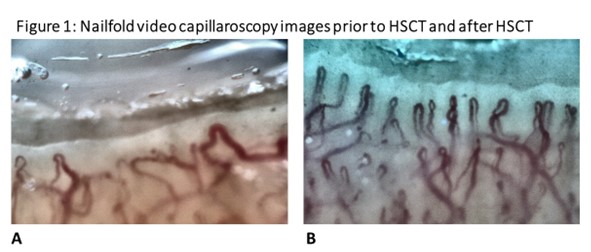Session Information
Session Type: Poster Session B
Session Time: 9:00AM-11:00AM
Background/Purpose: Autologous hematopoietic stem cell therapy (HSCT) is an effective therapy for patients with rapidly progressive systemic sclerosis (SSc) refractory to standard therapies. The disease is characterized by microvascular damage and dysfunction which can be observed using nailfold video capillaroscopy (NVC). NVC can be useful to examine the severity, activity, and stage of microvascular damage. At this time, there are few reported cases of NVC improvement after HSCT. Other therapies for SSc have not been found to provide reversal of the capillary abnormalities. Our objective was to evaluate the effect of HSCT on nailfold capillary changes in SSc.
Methods: Prospective study in patients diagnosed with SSc followed at our institution who underwent treatment with HSCT and had NVC images available pre- and post- treatment. All patients met the ACR 2013 classification criteria for SSc. Demographics, clinical features, serologies, date of diagnosis, laboratory data, last follow-up, response to treatment, NVC, and outcome were recorded. NVC was performed on all eight nailbeds using the 2nd-5th digits of both hands. Capillary morphology, density, organization, microhemorrhages, and ramifications of each nailbed were compared to determine the degree of vascular remodeling pre and post HSCT.
Results: A total of 5 patients diagnosed with SSc underwent HSCT. Mean age was 43.75 years with 4 women (80%) and 1 man (20%). Post-treatment images were collected at a median of 2 months (range 1-3 months) after HSCT. From baseline to follow-up, 80% of HSCT patients showed significant improvement in parameters including density, architecture, and microhemorrhages. The change in capillary density and disorganization to the resemblance of a normal capillary was seen in most patients. The most notable improvement was seen in one patient with scleroderma overlap syndrome with normal capillary density noted as early as one month post transplant in most of the fingers corresponding with significant clinical improvement in the modified Rodnan skin score. NVC findings showed overall positive changes with increased capillary density, reduced capillary loss, and improved capillary morphology.
Conclusion: Our findings support reversibility of the NVC changes in patients with SSc in a short time interval post HSCT. Further research is warranted to determine if microvascular improvements post HSCT contribute to the improved mortality and quality of life previously reported in the literature.
B. NVC performed after HSCT shows increased capillary density to normal, hairpin-shaped capillaries, and absence of enlarged capillaries
To cite this abstract in AMA style:
Balistreri L, Sullivan M, Berianu F, Ayala E, Abril A. Microvascular Remodeling After Autologous Stem Cell Transplant for Systemic Sclerosis [abstract]. Arthritis Rheumatol. 2023; 75 (suppl 9). https://acrabstracts.org/abstract/microvascular-remodeling-after-autologous-stem-cell-transplant-for-systemic-sclerosis/. Accessed .« Back to ACR Convergence 2023
ACR Meeting Abstracts - https://acrabstracts.org/abstract/microvascular-remodeling-after-autologous-stem-cell-transplant-for-systemic-sclerosis/

